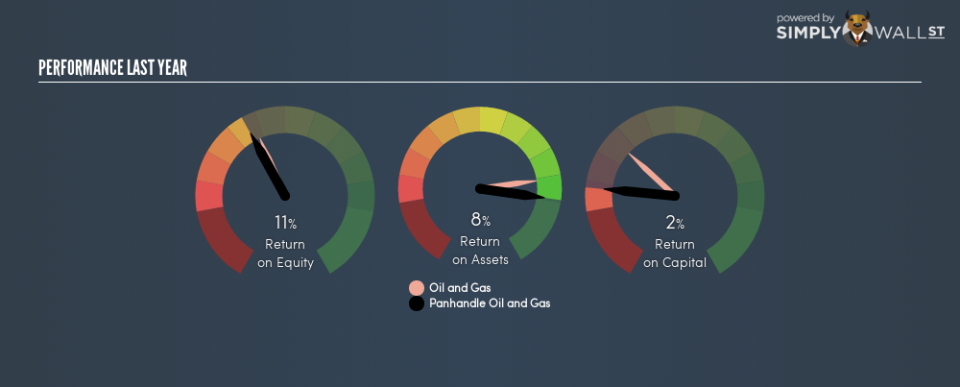Why Panhandle Oil and Gas Inc.’s (NYSE:PHX) Use Of Investor Capital Doesn’t Look Great

Today we’ll look at Panhandle Oil and Gas Inc. (NYSE:PHX) and reflect on its potential as an investment. Specifically, we’ll consider its Return On Capital Employed (ROCE), since that will give us an insight into how efficiently the business can generate profits from the capital it requires.
First of all, we’ll work out how to calculate ROCE. Second, we’ll look at its ROCE compared to similar companies. Finally, we’ll look at how its current liabilities affect its ROCE.
What is Return On Capital Employed (ROCE)?
ROCE is a metric for evaluating how much pre-tax income (in percentage terms) a company earns on the capital invested in its business. In general, businesses with a higher ROCE are usually better quality. Overall, it is a valuable metric that has its flaws. Renowned investment researcher Michael Mauboussin has suggested that a high ROCE can indicate that ‘one dollar invested in the company generates value of more than one dollar’.
How Do You Calculate Return On Capital Employed?
The formula for calculating the return on capital employed is:
Return on Capital Employed = Earnings Before Interest and Tax (EBIT) ÷ (Total Assets – Current Liabilities)
Or for Panhandle Oil and Gas:
0.019 = US$3.7m ÷ (US$207m – US$5.7m) (Based on the trailing twelve months to September 2018.)
Therefore, Panhandle Oil and Gas has an ROCE of 1.9%.
See our latest analysis for Panhandle Oil and Gas
Want to participate in a short research study? Help shape the future of investing tools and receive a $60 prize!
Is Panhandle Oil and Gas’s ROCE Good?
One way to assess ROCE is to compare similar companies. In this analysis, Panhandle Oil and Gas’s ROCE appears meaningfully below the 5.6% average reported by the Oil and Gas industry. This performance is not ideal, as it suggests the company may not be deploying its capital as effectively as some competitors. Putting aside Panhandle Oil and Gas’s performance relative to its industry, its ROCE in absolute terms is poor – considering the risk of owning stocks compared to government bonds. It is likely that there are more attractive prospects out there.
Panhandle Oil and Gas’s current ROCE of 1.9% is lower than its ROCE in the past, which was 6.3%, 3 years ago. Therefore we wonder if the company is facing new headwinds.
Remember that this metric is backwards looking – it shows what has happened in the past, and does not accurately predict the future. ROCE can be deceptive for cyclical businesses, as returns can look incredible in boom times, and terribly low in downturns. ROCE is only a point-in-time measure. We note Panhandle Oil and Gas could be considered a cyclical business. Future performance is what matters, and you can see analyst predictions in our free report on analyst forecasts for the company.
What Are Current Liabilities, And How Do They Affect Panhandle Oil and Gas’s ROCE?
Current liabilities are short term bills and invoices that need to be paid in 12 months or less. Due to the way the ROCE equation works, having large bills due in the near term can make it look as though a company has less capital employed, and thus a higher ROCE than usual. To counter this, investors can check if a company has high current liabilities relative to total assets.
Panhandle Oil and Gas has total assets of US$207m and current liabilities of US$5.7m. As a result, its current liabilities are equal to approximately 2.8% of its total assets. Panhandle Oil and Gas has a low level of current liabilities, which have a negligible impact on its already low ROCE.
What We Can Learn From Panhandle Oil and Gas’s ROCE
Still, investors could probably find more attractive prospects with better performance out there. You might be able to find a better buy than Panhandle Oil and Gas. If you want a selection of possible winners, check out this free list of interesting companies that trade on a P/E below 20 (but have proven they can grow earnings).
If you are like me, then you will not want to miss this free list of growing companies that insiders are buying.
To help readers see past the short term volatility of the financial market, we aim to bring you a long-term focused research analysis purely driven by fundamental data. Note that our analysis does not factor in the latest price-sensitive company announcements.
The author is an independent contributor and at the time of publication had no position in the stocks mentioned. For errors that warrant correction please contact the editor at editorial-team@simplywallst.com.

